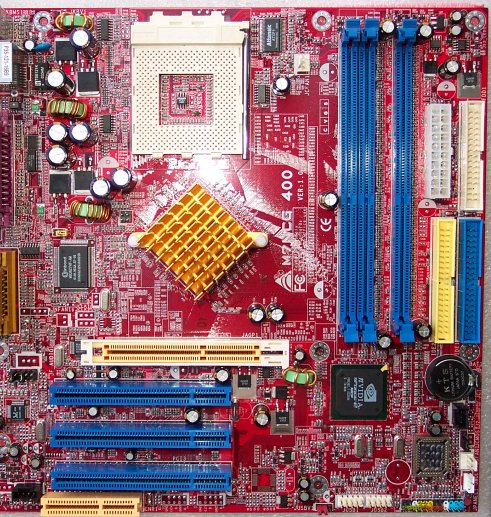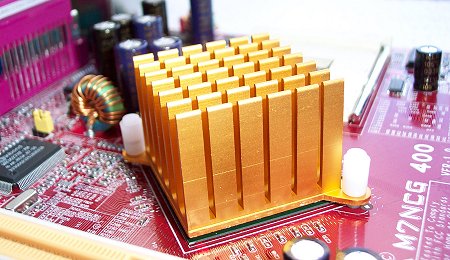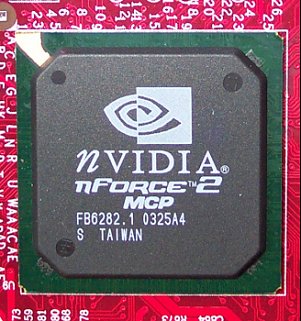M7NCG 400 Layout and Features
The question we'll pose ourselves is whether microATX boards can emulate the qualities of decent full-size motherboards. By their very nature, microATX boards should be cheaper to produce and market, partly due to the lack of PCB usage. Our two comparison boards, if you can call them that, are from Biostar. The AMD K7-powered M7NCG 400 (Socket A, NVIDIA nForce2 with a twist) and the K8NHA-M (NVIDIA nForce3 150) Both support 200FSB processors and a wealth of extras, yet the latter will be equipped with the more potent Athlon 64 CPU. We'll be looking at the M7NCG 400 first.
The microATX form factor calls for motherboards that must adhere to a maximum PCB size of 244mm x 244mm. The relative size of the DIMM slots is proof enough of its small PCB footprint. It's quite normal for a microATX board to look a little cluttered, after all, it's to house all the constituent parts that make up a regular board. However, it's large enough to accommodate three PCI slots as standard. Looking at it from an overhead shot we see that there's no mounting holes around the ZIF socket. That negates the possibility of mounting larger, more effective air coolers and a number of watercooling kits. Biostar may respond with the fact that this is not explicitly aimed at those who wish to push their components to the brink.
The nForce2 chipset, and this one being a strange hybrid of dual-channel memory support at DDR333 speeds and full 200MHz FSB CPU support, is perhaps still the best choice for S462 CPUs, including the latest XP3200+ Barton, a CPU that runs off a native 200MHz FSB. The initial trouble is that it is the only current K7 AMD CPU to do so, but that won't stop enthusiasts from picking up lower speed CPUs and raising to FSB to 200MHz and beyond. Higher speeds necessitate better, cleaner voltage supplies. Biostar uses a 3-phase PWM on this model. That's in keeping with most other manufacturers.

The hefty aluminium heatsink cools the North Bridge. Noise, or lack of it, may play a part in a potential mATX buyer's decision. Biostar, thankfully, goes with a passive model. The nForce2 NB, as you may know, can be differentiated into IGP (Integrated Graphics Processor) and SPP (System Platform Processor) camps. Up until now, the IGP model, featuring an integrated GeForce4 MX class of GPU, has been limited to motherboards that only officially support 166MHz FSB CPUs. Here, though, Biostar has managed to meld in the GF4MX into an IGP that runs off the aforementioned 200MHz FSB.
On a sidenote, the locations of the power and port connections is excellent. We like to see them grouped on one side. It makes it easier to route wires out of the way of the fans' airflow. Component placing is far more important when you have comparatively little PCB space to play around with. It's difficult to remove system memory once a graphics card is in place, and the first PCI slot is almost useless considering that one would be heavily compromising the GPU cooler's airflow. Biostar implements a CNR (Communications and Network Riser) slot too.

Biostar also opts for the 'lightweight' version of the nForce2 South Bridge here. The MCP (non-T) still carries decent sound, albeit not from NVIDIA's excellent APU. It skips out on FireWire support, DualNet use and the lovely APU. What was once considered to be the pinnacle of SB design is looking a little jaded in comparison to competition that offers on-chip SATA as standard. Speaking of which, there's no provision here via the usual discrete controller route. The prevalence of SATA drives today, and the sheer simplicity of its cabling makes it a decent partner for any mATX board.

Biostar uses the Realtek ALC650 sound CODEC as a physical layer for sound output. It's a decent match for NVIDIA's 20-bit audio resolution ability, but it's not quite as nice as Realtek's newer ALC658 CODEC that's been seen on the ABIT AI7 Springdale, for example. 6-channel sound, albeit software-driven, isn't to be sniffed at. Biostar has opted not to take advantage of the digital S/PDIF transfer option, either by providing a working header on the PCB or compliant input / output jacks on the I/O panel, which is a shame.

Nothing all that new except for the HD15 VGA output. We're left lamenting why manufacturers don't automatically extend the usefulness of onboard graphics by providing a standard S-Video connection. Watching, say, DivX rips on a large TV screen is almost justification enough for buying a media-based PC. We'd also have liked FireWire support, most likely via a Texas Instruments or VIA single-chip controller.









